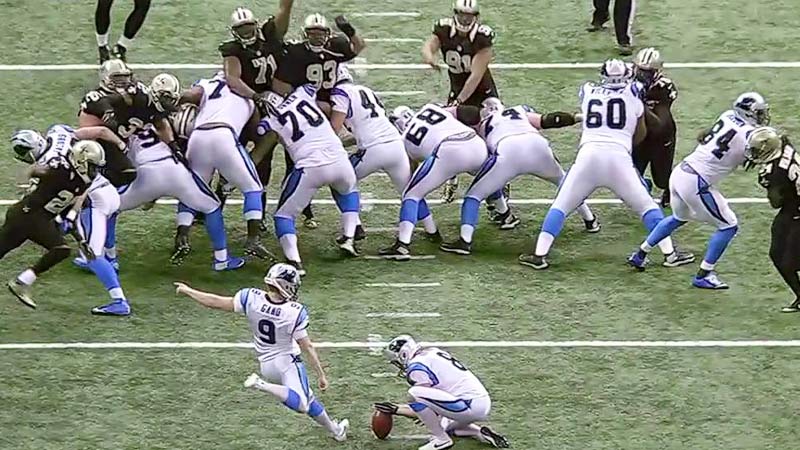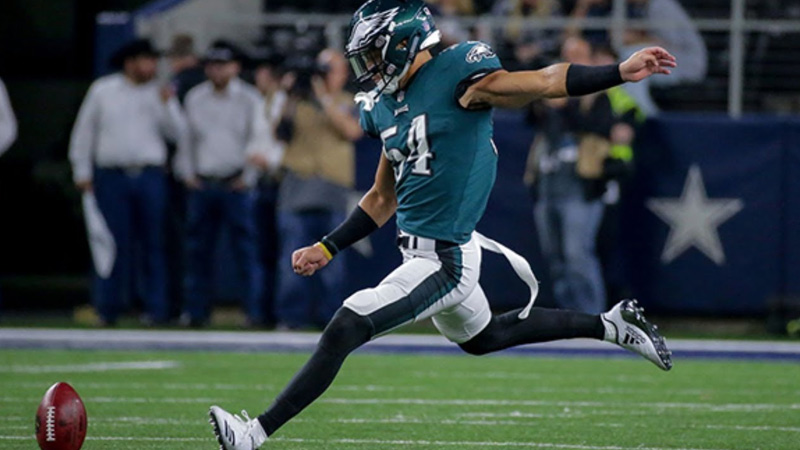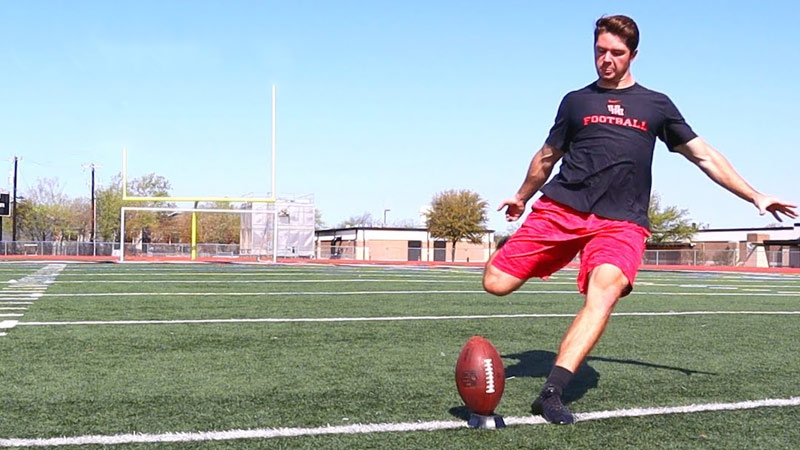Football, a sport celebrated for its thrilling moments and exhilarating plays, showcases a wide array of kicking techniques that play pivotal roles in shaping the game’s outcome.
From the precise artistry of place kicks and field goals to the soaring beauty of punts, football kick types exhibit the versatility and skill of players on the field.
Each kick serves a distinct purpose, whether it’s earning points, flipping field position, or strategically challenging the opponent.
The proficiency of kickers and punters becomes evident as they employ these various techniques to alter the course of a match.
This comprehensive exploration of football kick types delves into the intricacies and significance of each manoeuvre, highlighting how these football kick types contribute to the intensity and drama that define the sport.
Football Kick Types
Here are some popular football kick types-
Place Kick
The place kick is one of the most common and traditional types of kicks in football. It is used for field goals, extra points, and kickoffs.
The ball is held stationary on the ground, and the kicker strikes it with their foot to send it through the goalposts or deep down the field.
Punt
The punt is another crucial kick in football, primarily employed by the punter to change field position. The punter drops the ball from their hands and kicks it before it hits the ground.
This high, arcing kick aims to send the ball deep into the opponent’s territory while minimizing the chance of a return.
Field Goal
Field goal kicks are taken during a team’s possession to score points. The kicker attempts to send the ball through the opponent’s goalposts, either from a snap for a place kick or a hold for a field goal attempt during a play.
Extra Point (PAT)
After a touchdown, the scoring team has the option to kick an extra point. The kicker takes a short place kick from the 2-yard line to earn one point for the successful conversion.
Drop Kick
Though rare in modern football, the drop kick involves the kicker dropping the ball and kicking it as it bounces off the ground. It was more common in the early days of football, and its use has become almost obsolete in the modern game.
Squib Kick
The squib kick is employed on kickoffs to prevent a long return by bouncing the ball along the ground. It aims to make the return challenging for the receiving team and reduce the risk of a big play.
Onside Kick
The onside kick is a high-risk, high-reward tactic used during kickoffs. The kicking team aims to recover the ball themselves, hoping to maintain possession after the kick.
It is typically attempted when a team is trailing late in a game and needs a quick possession change.
Coffin Corner Punt
The coffin corner punt is a precise and challenging kick typically used by punters aiming to pin the opposing team near their end zone.
The punter attempts to land the ball near the sideline inside the 5-yard line, making it challenging for the receiving team to return the ball.
Rugby-Style Kick
Popularized by Australian Rules football and rugby, the rugby-style kick has become more common in American football.
Instead of kicking straight on, the punter or kicker approaches the ball at an angle and kicks it with their non-dominant foot, aiming for distance and a spiral trajectory.
Trick Kicks
Trick kicks are rare but entertaining manoeuvres attempted in unique situations. Examples include fake punts, fake field goals, or drop-kick attempts during unconventional plays.
Rugby-Style Punt
Similar to the rugby-style kick, the rugby-style punt involves the punter running to the side before punting the ball. This allows the punter to buy time for the coverage team to get downfield and limit the return opportunities for the receiving team.
Sky Punt
The sky punt is a high, towering punt intended to give the coverage team ample time to get downfield and make a tackle. This type of punt often results in fair catches by the returner due to its hang time and distance.
Pooch Kick
The pooch kick is a strategic kickoff, aiming to drop the ball just behind the receiving team’s front line. It disrupts the usual kickoff return formation and can lead to an advantageous field position for the kicking team.
Football kickers and punters must be proficient in various types of kicks to be effective in different game situations. Each kick requires precision, timing, and technique to achieve the desired outcome and contribute to the team’s success.
What Is The Easiest Kick In Football?

The easiest kick in football is the extra point (PAT) kick. It is commonly regarded as straightforward because of its short distance and relatively low level of difficulty compared to other kicks in the game.
Here are the reasons why the extra-point kick is considered the easiest:
1. Short Distance
The extra point kick is taken from the 2-yard line, making it only a 20-yard attempt for the kicker. This distance is significantly shorter than field goals, which can be attempted from much farther distances depending on the team’s position on the field.
2. Stationary Ball
Unlike punts or kickoffs, the ball is held stationary on the ground for the extra point kick. This eliminates the need for a running start or complicated timing, making it simpler for the kicker to focus on their form and technique.
3. Consistent Conditions
The extra point kick is typically taken on artificial turf or well-maintained grass, ensuring a consistent and even surface for the kicker. The field conditions are less likely to be a factor in this type of kick compared to others that require precise foot placement and stability.
4. Limited Defensive Pressure
After a touchdown, the defence is not allowed to rush the extra point kick. This reduces the pressure on the kicker, as they have ample time to set up and execute the kick without worrying about defenders attempting to block it.
5. High Success Rate
Professional kickers and college kickers often have a high success rate for extra point attempts. The kick is considered routine for most skilled kickers, and they can make it with a high degree of accuracy.
Overall, the extra point kick is considered the easiest kick in football due to its short distance, stationary ball, consistent field conditions, limited defensive pressure, and high success rate among proficient kickers.
However, even though it is considered easy, every point matters in football, and kickers must remain focused and accurate during each attempt to contribute to their team’s success.
How Far Does An Onside Kick Need To Go?

An onside kick, also known as an outside kick, is a specialized and strategic type of kick used in football to regain possession of the ball after a score.
To be considered a legal onside kick, it needs to travel a minimum distance and meet specific requirements.
Here are the key points regarding how far an onside kick needs to go:
1. Legal Minimum Distance
In most football leagues, including the NFL and NCAA, the onside kick must travel a minimum of 10 yards from the spot of the kickoff before it can be touched by the kicking team or the receiving team.
If the ball does not travel at least 10 yards, the kick is deemed illegal, and the receiving team will be awarded possession at the spot where the ball was first touched or possessed.
2. Restrictions on Touching the Ball
Until the onside kick travels the required 10 yards, members of the kicking team are prohibited from touching the ball.
Conversely, members of the receiving team can attempt to recover the ball at any time, even if it has not reached the minimum distance.
If the ball travels 10 yards and is recovered by the kicking team or if it touches a member of the receiving team, it becomes a live ball, and either team can attempt to gain possession.
3. Avoiding the Receiving Team
Onside kicks are challenging to execute successfully since the receiving team is aware of the kicking team’s intentions and will position themselves strategically to recover the ball.
Kicking teams often aim to kick the ball in such a way that it takes unpredictable bounces, making it harder for the receiving team to catch cleanly.
4. Game Situation and Timing
The decision to attempt an onside kick often depends on the game situation, including the score, time remaining, and the team’s overall strategy.
Teams usually attempt onside kicks when they are trailing late in the game and need to regain possession quickly to mount a comeback.
5. Precision and Execution
Executing a successful onside kick requires precision, timing, and coordination among the kicking team’s players. Kickers must place the ball in a specific spot to optimize the chances of a successful recovery by their teammates.
The kicking team must also engage in a coordinated effort to create opportunities for one of their players to secure the ball.
The onside kick is a high-risk, high-reward manoeuvre that can significantly impact the momentum and outcome of a football game.
Its success hinges on meeting the minimum distance requirement, outmanoeuvring the receiving team, and securing possession in a crucial game situation.
FAQ
Q: What are the different types of kicks in football?
A: Football showcases a variety of kicks, including the place kick (used for field goals, extra points, and kickoffs), punt (for changing field position), drop kick (a rarely seen kick), onside kick (for attempting to regain possession), and squib kick (to limit the return on kickoffs).
Q: What is the purpose of a punt in football?
A: The punt is a key kicking technique used primarily by the punter to flip the field position. It involves kicking the ball high and far to the opponent’s territory to force them to start their offensive possession from a disadvantageous position, thus aiding the team’s defence.
Q: How does a place kick differ from a punt in football?
A: The key difference between a place kick and a punt lies in the setup and execution. In a place kick, the ball is held stationary on the ground, and the kicker strikes it with their foot, usually aiming for the goalposts.
Q: When is an onside kick typically used in a football game?
A: An onside kick is a strategic kick often employed when a team is trailing in the game and needs to quickly regain possession.
It involves kicking the ball a short distance with the intention of recovering it themselves rather than attempting a deep kickoff to the opposing team.
Q: What is the purpose of a drop kick in football?
A: The drop kick is a rare and unconventional kick where the ball is dropped to the ground by the kicker and then kicked as it bounces up. While not commonly seen in modern football, the drop kick was more prevalent in the early days of the sport and is occasionally attempted for special situations or as a novelty play.
Conclusion
Football kick types, a multifaceted aspect of the sport, exemplify the artistry and precision wielded by players on the field.
Whether it’s the impactful field goal that secures a last-minute victory or the masterful coffin corner punt that pins the opponent deep in their territory, each kick type serves a crucial role in shaping the game’s narrative.
Kicking specialists continuously refine their techniques, understanding the significance of their contributions to their team’s success. The symphony of football kick types unfolds during each game, with fans witnessing the execution of place kicks, punts, onside kicks, and more.
From thrilling game-winners to field-flipping punts, these kicking manoeuvres exemplify the essence of precision, strategy, and athleticism that make football a beloved spectacle around the world.
As players and teams continue to innovate and push the boundaries of football kick types, this fundamental aspect of the game remains a cornerstone of its enduring legacy.







